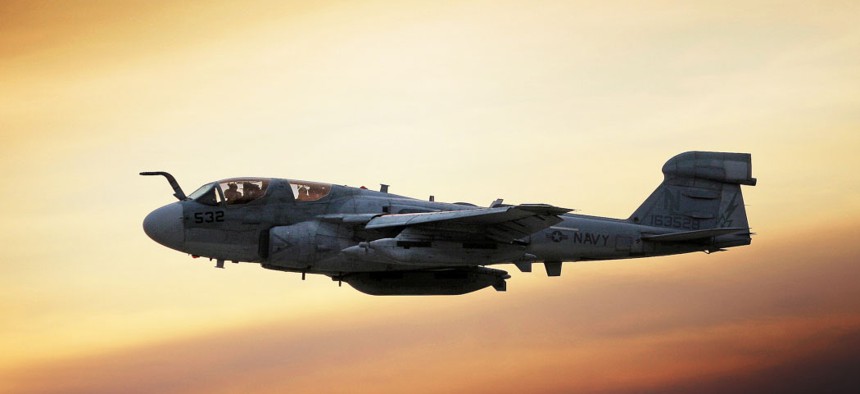DOD adds electronic attack aircraft to the fight against ISIS
The Defense Department has announced that EA-6B Prowler aircraft, specializing in tactical jamming capabilities, have deployed to support the anti-ISIS efforts.
The Defense Department has turned to a wide array of capabilities in its fight to deal ISIS a “lasting defeat,” in the words of Defense Secretary Ashton Carter. In an announcement late this week, DOD said EA-6B Prowler aircraft from the Marine Corps Tactical Electronic Warfare Squadron 4 have deployed to Turkey to “support electronic attack requirements in Operation Inherent Resolve, the effort to counter” ISIS, also known as ISIL.
The Prowler, made by Northrop Grumman, provides tactical jamming capabilities from above with a primary role of “protect[ing] fleet surface units and strike aircraft by jamming enemy radar and communications, and perform electronic surveillance,” according to the company.
“This electronic countermeasure capability has been a part of our strike packages in both Iraq and Syria since the beginning of OIR,” a spokesperson with the office of the Secretary of Defense told Defense Systems in an email. “The Prowler provides an umbrella of protection to coalition aircraft and ground troops in the fight against ISIL by intercepting communications as well as denying the enemy's ability to communicate. The EA-6B Prowler is a force multiplier, continuing to do what it has for the past 45 years: support warfighters flying in the air and fighting on the ground by giving them the electronic communications dominance to ensure a decisive win.”
Electronic or signals intelligence has been one of the primary methods of tracking and locating terrorists overseas. Aerial and other sensors have captured the cell phone signals of militants, allowing the military to pinpoint the location of an asset. However, the practice has come under fire from several detractors who believe relying on signals intelligence alone without other intelligence disciplines substantiating targets leads to cases of either mistaken identity or unnecessary collateral damage.
Recent high-profile ISIS casualties, such as its suspected minister of war and its No. 2 leader, suggest to many outside experts that the U.S. military effort has made significant headway in terms of its intelligence capabilities in identifying and locating targets. Electronic and signals intelligence doubtlessly have played a large role in this collective effort.
The United States has also recently tasked the U.S. Cyber Command with what Carter described as “its first wartime assignment.” Carter elaborated on the capabilities Cyber Command has at its disposal to combat ISIS; “[I]nterrupting their ability to command and control their forces, interrupting their ability to plot, including against us here, and anywhere else against our friends and allies around the world. Interrupting their finances—their ability to pay people—their ability to dominate the population on whose territories they have tried to establish this nasty ideology.”
Carter and, most recently, his deputy Bob Work have noted that the U.S. is dropping “cyber bombs” on ISIS, though the term is still relatively vague in terms of an operational capability. “[T]hese are strikes that are conducted in the warzone using cyber essentially as a weapon of war just like we drop bombs. We’re dropping cyber bombs,” Carter told NPR in February.





